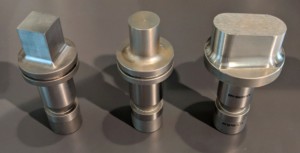 As one of the stops on our van full of nerds touring southern Germany to study Industry 4.0, we also visited Trumpf. However, we didn’t go to the main plant in Ditzingen but to a much-smaller plant in Gerlingen that makes stamping tools. I have heard a lot of good things about Trumpf Gerlingen, and wanted to see if it is true. Let’s find out:
As one of the stops on our van full of nerds touring southern Germany to study Industry 4.0, we also visited Trumpf. However, we didn’t go to the main plant in Ditzingen but to a much-smaller plant in Gerlingen that makes stamping tools. I have heard a lot of good things about Trumpf Gerlingen, and wanted to see if it is true. Let’s find out:
Trumpf Plant in Gerlingen
The Plant
 Trumpf is a famous family-owned German machine tool maker. I like their lean approach (called Synchro) quite a lot, and also wrote about it on this blog. However, the focus of this visit was not lean but Industry 4.0. We visited the much-smaller plant in Gerlingen, which has only 75 employees (out of 13,000 worldwide). This plant has a good reputation for its highly automated manufacturing system.
Trumpf is a famous family-owned German machine tool maker. I like their lean approach (called Synchro) quite a lot, and also wrote about it on this blog. However, the focus of this visit was not lean but Industry 4.0. We visited the much-smaller plant in Gerlingen, which has only 75 employees (out of 13,000 worldwide). This plant has a good reputation for its highly automated manufacturing system.
Below you see two examples of their punching tools, with a multi-tool in the second row. The first column is the top (the punch), the second the bottom (the die), and the third a punched sample of sheet metal. They also have a carrier that is not pictured here.
What impressed us most about Trumpf Gerlingen was their clear purpose. They really asked thoroughly what they want to achieve, and then worked on achieving this goal. Okay, you may think this sounds easy, but it is not! Many of the other locations we visited rushed this step, and it often felt like they started with the solution (something with computers, obviously) and then looked for the matching problem. This is terribly wrong! At Trumpf Gerlingen, they asked, “Why do we want to do this?” and we as lean guys really like this approach. On a side note, I also saw this in their much-larger main plant in nearby Ditzingen, so it indeed seems to be part of the corporate culture!
Industry 4.0 Aspects
Anyway, their Industry 4.0 journey in Gerlingen started in 2009. Their clear goal was to get the part to the customer faster in order to stay competitive. Their motto was “The Customer starts the Machine.” In 2015 they moved to paperless manufacturing, adding a data matrix code to every part with the motto “The Workpiece as Information Carrier.” In 2017 they implemented the option to send in a photo of the part (the data matrix code) to reorder the same part again, with the motto “Photo Starts Machine” (although the customers don’t really use this much since the purchasing at the customer is usually far away from the part on the shop floor). This automated system works for the high runners and less-complex products (70% of volume). Their next goal is to extend the system to include more of the complex products, as for example multi-tool punches.

Their system is quite nice. It all starts with their online shop for punching tools. With only a few clicks, registered Trumpf customers can select the shape, the dimensions, and other parameters of the tool. Only for more-complex tools do they need to interact with a Trumpf salesperson. Overall, this system allows for about 31 million possible punches, way too many for them to keep in stock. Once the customer clicks to order, the whole system goes into action. The order is added seamlessly to the Trumpf computer system. A punching tool consists of a punch at the top, a die at the bottom, and a stripper in between. These themselves can consist of multiple parts.
 Trumpf has 176 blanks for punches and 4 blanks for dies. Let’s first look at the punches. Based on the order, a matching blank is selected. The first step is to laser engrave a data matrix code on the top of the blank. This code is unique and directly linked to the order. At every subsequent machine, the machine scans this code and automatically uses the correct program for this customer order, all of which in lot size one. No human interaction is needed except for bringing the parts to the machine. After the laser engraving, the punch goes to a grinding machine, which scans the code, selects the correct grinding wheel, and grinds the shape of the blank punch into the customer’s desired shape. Another laser-engraving process adds text or an image, as chosen by the customer, to the side of the shaft.
Trumpf has 176 blanks for punches and 4 blanks for dies. Let’s first look at the punches. Based on the order, a matching blank is selected. The first step is to laser engrave a data matrix code on the top of the blank. This code is unique and directly linked to the order. At every subsequent machine, the machine scans this code and automatically uses the correct program for this customer order, all of which in lot size one. No human interaction is needed except for bringing the parts to the machine. After the laser engraving, the punch goes to a grinding machine, which scans the code, selects the correct grinding wheel, and grinds the shape of the blank punch into the customer’s desired shape. Another laser-engraving process adds text or an image, as chosen by the customer, to the side of the shaft.
 There are much fewer variants of blank punches (around 4), and they are already engraved with a unique data matrix code. But here, too, a robot automatically selects the correct blank and adds it into an electric discharge machine (EDM). At the EDM, the data code is uniquely linked to the customer order, and again all subsequent machines simply scan the code and select the correct program. Overall, for standard tools the only human interaction between the customer order and the packaging is the testing and transport; everything else is fully automatic based on the data matrix code.
There are much fewer variants of blank punches (around 4), and they are already engraved with a unique data matrix code. But here, too, a robot automatically selects the correct blank and adds it into an electric discharge machine (EDM). At the EDM, the data code is uniquely linked to the customer order, and again all subsequent machines simply scan the code and select the correct program. Overall, for standard tools the only human interaction between the customer order and the packaging is the testing and transport; everything else is fully automatic based on the data matrix code.
The results are impressive. Trumpf Gerlingen manages mass customization of their tools. If a customer orders a (non-complex) tool before 2:00 PM, the order is shipped on the same day. This is despite a huge fluctuation of orders, between 200 and 1500 per day. Including custom tools, 45% of the products arrive at the customer on the same or next day. Before 2009 it took them, on average, three days to produce an order; now it is down to less than one day. Personally, I was also surprised at the price, where punching tools can cost as little as €30. This gives them a market share of 70% for punching tools in Europe. In China they have only 5%–10%, since the Chinese market values price more than quality. They have around three days’ worth of inventory of blanks in their warehouse.
Lean Aspects
Overall, we were quite impressed with their system, and also with their focus on performance rather than appearance. However, while the digital side works excellently, the flow of parts in the plant seems less structured, and cleanliness on a lower level compared to the other plants. Both material flow and cleanliness are much better in the main plant, Trumpf Ditzingen. Overall, many of us, including me, liked the Industry 4.0 aspects of Trumpf Gerlingen, especially their clear direction on what they want to achieve. They aimed to reduce the barriers between the customer and production, and made a quite seamless integration of the ordering process.
In my next post we will visit another impressive plant, the Bosch wafer fab in Reutlingen. Until then, stay tuned, go out, and organize your industry!
P.S.: Thank you very much to everybody who hosted us and showed us their plants and products!
Post Series Overview
- Industry 4.0 Tour in Germany – A Van Full of Nerds – Overview and Audi
- Industry 4.0 Tour in Germany – A Van Full of Nerds – ABB Stotz-Kontakt
- Industry 4.0 Tour in Germany – A Van Full of Nerds – Trumpf Gerlingen
- Industry 4.0 Tour in Germany – A Van Full of Nerds – Bosch Reutlingen Wafer Fab
- Industry 4.0 Tour in Germany – A Van Full of Nerds – Kärcher and Siemens
- Industry 4.0 Tour in Germany – A Van Full of Nerds – Presentations and Tryouts



Thanks for sharing your findings from the visits, Christoph. It is very helpful as we all keep getting these questions about what is Industry 4.0, really, and how does it relate to lean thinking or TPS. Your findings at Trumpf highlight the all-important place of clarifying purpose. Without adequate attention to that piece, any approach becomes a “check the box” exercise and your visit shows that this thinking applies to Industry 4.0 as well. I would think this would also be the clarifying question regarding how Industry 4.0 relates to “lean”. Looking forward to reading the rest of the series. – john
Hi John, many thanks for the kind words. Hope to see you at the webinar soon to talk more about Industry 4.0.
Great series Christoph.
I visited Trumpf’s Ditzingen plant in 2016 (as a customer) and was extremely impressed how they were able to emulate a flow line with such large products and varying work content.
I’ve enjoyed many battles while introducing Lean concepts of Takt and one-piece-flow in manufacturing facilities. What I saw at Trumpf convinced me there really are no valid excuses for not doing so.
I’m looking forward to the next articles in this series.
Hi Neil, I also liked Ditzingen quite a lot. So much that I wrote two blog posts about it: https://www.allaboutlean.com/trumpf-synchro-1/ and https://www.allaboutlean.com/trumpf-synchro-2/ . Indeed a very cool company!
Nice post Christoph, very clear. Thank you.